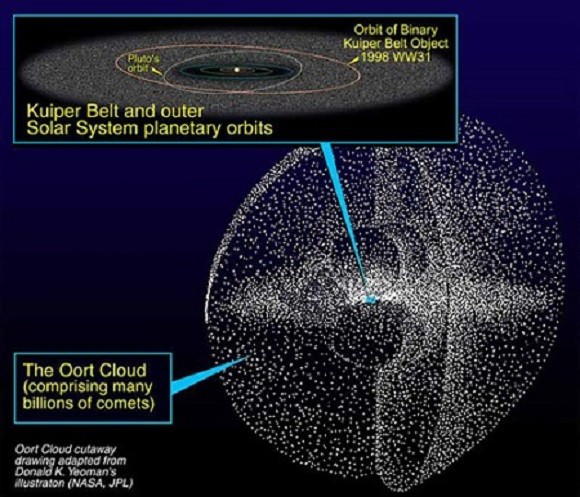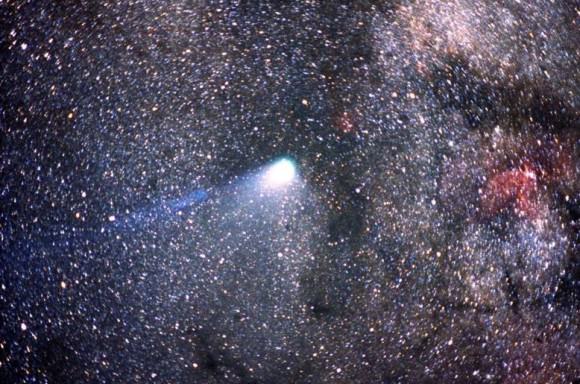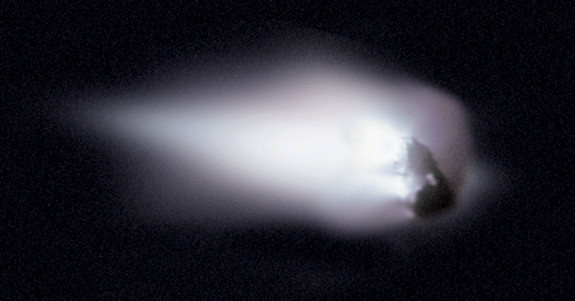Halley’s Comet, also known as 1P/Halley, is the most well known comet in the Solar System. As a periodic (or short-term comet) it has orbital period that is less than 200 years, and has therefore been observed more than once by people here on Earth over the centuries.
It’s appearance in the skies above Earth has been noted since ancient times, and was associated with both bad and good omens by many cultures. But in truth, its behavior is no different than any short-term visitor that swings by from time to time. And its visits have become entirely predictable!
Discovery:
Halley’s Comet has been observed and recorded by astronomers since at least 240 BCE, with clear references to the comet being made by Chinese, Babylonian, and medieval European chroniclers. However, these records did not recognize that the comet was the same object reappearing over time. It was not until 1705 that English astronomer Edmond Halley, who used Newton’s Three Laws of Motion to determine that it was periodic.
Until the Renaissance, astronomers’ believed that comets – consistent with Aristotle’s views – were merely disturbances in the Earth’s atmosphere. This idea was disproved in 1577 by Tycho Brahe, who used parallax measurements to show that comets must lie beyond the Moon. However, for another century, astronomers would continue to believe that comets traveled in a straight line through the Solar System rather than orbiting the Sun.
In 1687, in his Philosophiæ Naturalis Principia Mathematica, Isaac Newton theorized that comets could travel in an orbit of some sort. Unfortunately, he was unable to develop a coherent model for explaining this at the time. As such, it was Edmond Halley – Newton’s friend and editor – who showed how Newton’s theories on motion and gravity could be applied to comets.
In his 1705 publication, Synopsis of the Astronomy of Comets, Halley calculated the effect that Jupiter and Saturn’s gravitational fields would have on the path of comets. Using these calculations and recorded observations made of comets, he was able to determine that a comet observed in 1682 followed the same path as a comet observed in 1607.
Pairing this with another observation made in 1531, he concluded that these observations were all of the same comet, and predicted that it would return in another 76 years. His prediction proved to be correct, as it was seen on Christmas Day, 1758, by a German farmer and amateur astronomer named Johann Georg Palitzsch.
His predictions not only constituted the first successful test of Newtonian physics, it was also the first time that an object besides the planets was shown to be orbiting the Sun. Unfortunately for Halley, he did not live to see the comet’s return (having died in 1742). But thanks to French astronomer Nicolas Louis de Lacaille, the comet was named in Halley’s honor in 1759.

Origin and Orbit:
Like all comets that take less than about 200 years to orbit the Sun, Halley’s Comet is believed to have originated from the Kuiper Belt. Periodically, some of these blocks of rock and ice – which are essentially leftover matter from the formation of the Solar System some 4.6 billion years ago – are pulled deeper into the Solar System and becomes active comets.
In 2008, another point of origin for the Halley-type comets had been proposed when a trans-Neptunian object with a retrograde orbit similar to Halley’s was discovered. Known as 2008 KV42, this comet’s orbit takes it from just outside the orbit of Uranus to twice the distance of Pluto. This suggests that Halley ‘s Comet could in fact be member of a new population of small Solar System bodies that is unrelated to the Kuiper Belt.
Halley is classified as a periodic or short-period comet, one with an orbit lasting 200 years or less. This contrasts with long-period comets, whose orbits last for thousands of years and which originate from the Oort Cloud – the sphere of cometary bodies that is 20,000 – 50,000 AU from the Sun at its inner edge. Other comets that resemble Halley’s orbit, with periods of between 20 to 200 years, are called Halley-type comets. To date, only 54 have been observed, compared with nearly 400 identified Jupiter-family comets.

Halley’s orbital period over the last 3 centuries has been between 75–76 years, although it has varied between 74–79 years since 240 BC. Its orbit around the Sun is highly elliptical. It has a perihelion (i.e. the point where it is nearest the Sun) of just 0.6 AU, which places it between the orbits of Mercury and Venus. Meanwhile, it’s aphelion – the farthest distance from the Sun – is 35 AU, the same distance as Pluto.
Unusual for an object in the Solar System, Halley’s orbit is retrograde – which means that it orbits the Sun in the opposite direction to the planets (or clockwise from above the Sun’s north pole). Due to the retrograde orbit, it has one of the highest velocities relative to the Earth of any object in the Solar System.
The orbits of the Halley-type comets suggest that they were originally long-period comets whose orbits were perturbed by the gravity of the gas giants and directed into the inner Solar System. If Halley was once a long-period comet, it is likely to have originated in the Oort Cloud. However, Halley is believed to have been a short-term comet for the past 16,000–200,000 years.
Because its orbit comes close to Earth’s in two places, Halley is the parent body of two meteor showers: the Eta Aquariids in early May, and the Orionids in late October. Observations conducted around the time of Halley’s appearance in 1986, however, suggest that the Eta Aquarid meteor shower might not originate from Halley’s Comet, although it might be perturbed by it.

Structure and Composition:
As Halley approaches the Sun, it expels jets of sublimating gas from its surface, which knock it very slightly off its orbital path. This process causes the comet to form a bright tail of ionized gas (ion tail), and a faint one made up of dust particles. The ion tail is also known as a coma (a small atmosphere) which spans up to 100,000 km across and consists of violatiles such as water, methane, ammonia and carbon dioxide.
Despite the vast size of its coma, Halley’s nucleus is relatively small – barely 15 kilometers long, 8 kilometers wide and roughly 8 kilometers thick. Its mass is also relatively low (an estimated 2.2 × 1014 kg, or 242.5 billion tons) and its average density is about 0.6 g/cm3, indicating that it is made of a large number of small pieces held loosely together.
Spacecraft observations have shown that the gases ejected from the nucleus were 80% water vapor, 17% carbon monoxide and 3–4% carbon dioxide, with traces of hydrocarbons (although more-recent sources give a value of 10% for carbon monoxide and also include traces of methane and ammonia).
The dust particles have been found to be primarily a mixture of carbon–hydrogen–oxygen–nitrogen (CHON) compounds – which are common in the outer Solar System – and silicates, like those found in terrestrial rocks. At one time, it was thought that Halley could have delivered water to Earth in the distant past – based on the ratio of deuterium to hydrogen found in the comet’s water that showed it to be chemically similar to the Earth’s oceans. However, subsequent observations have indicated that this is unlikely.

The ESA’s Giotto (1985-1992) and Russia’s Vega missions (1986) gave planetary scientists their first view of Halley’s surface and structure. The images could only capture roughly 25% of the comet’s surface, but nevertheless revealed an extremely varied topography – with hills, mountains, ridges, depressions, and at least one crater.
Role in Myths and Superstitions:
As already noted, Halley’s Comet has a long and rich history when it comes to being observed by humans. Including its most recent visits, Halley’s Comet has been visible from Earth on 30 separate occasions. The earliest record of which were the Shih Chi and Wen Hsien Thung Khao chronicles, written in China ca. 240 BCE.
While it is believed that Babylonian scribes recorded the appearance of Halley’s Comet when it returned in 164 and 87 BCE, it’s most famous appearance occurred shortly before the 1066 invasion of England by William the Conqueror. Whereas King Harold of England saw the comet as a bad omen, William and his forces interpreted it as a sign of their impending victory (at least according to legend).
Throughout the Middle Ages, the appearances of comets in the night sky were seen as heralds of bad news, indicating that either a person of royal standing had died, or that dark days lay ahead. This is perhaps owing to what was seen as the erratic and unpredictable behavior of comets, when compared to the Sun, the Moon and the stars.

With the development of modern astronomy, this view of comets has been largely dispelled. However, there are many who still hold to the “doom and gloom” view of Halley’s Comet, believing that it will strike the Earth at some point and trigger an Extinction Level Event, the likes of which has not been seen since the Dinosaurs.
Disappearance:
Halley’s overall lifespan is difficult to predict, and opinions do vary. In 1989, Russian astronomers Boris Chirikov and Vitaly Vecheslavov performed an analysis of 46 apparitions of Halley’s Comet taken from historical records and computer simulations. Their study showed that the comet’s dynamics were chaotic and unpredictable over long timescales, and indicated that its lifetime could be as long as 10 million years.
In 2002, David C. Jewitt conducted a study that indicated that Halley will likely evaporate, or split in two, within the next few tens of thousands of years. Alternately, Jewitt predicted that it could survive long enough to be ejected from the Solar System entirely within a few hundred thousand years.
Meanwhile, observations conducted by D.W. Hughes et al. suggests that Halley’s nucleus has been reduced in mass by 80–90% over the last 2000–3000 revolutions (i.e. 150,000 – 230,000 years). By their estimations, it would not be surprising at all if the comet evaporated entirely within the next 300 revolutions or so (approx. 25,000 years).
The last time Halley’s Comet was seen was in 1986, which means it will not reappear until 2061. As always, some are choosing to prepare for the worst – believing its next pass will signal the end of life as we know it – while others are contemplating if they will live long enough to witness it.
Universe Today has articles on famous comets and distant Halley’s Comet.
For more information, take a look at Comet Halley and Halley’s Comet.
Astronomy Cast has an episode on comets.


I’m confused how a comet that lost >80% of its mass still has a crater on it on a scale of 10s of thousands of years. Could a crater have formed from some impact? Yes – but it certainly would have altered the orbit. But just a comment about the chaotic nature of comet orbits (thanks to jetting and mass loss as well as moderate gravitational influences?)